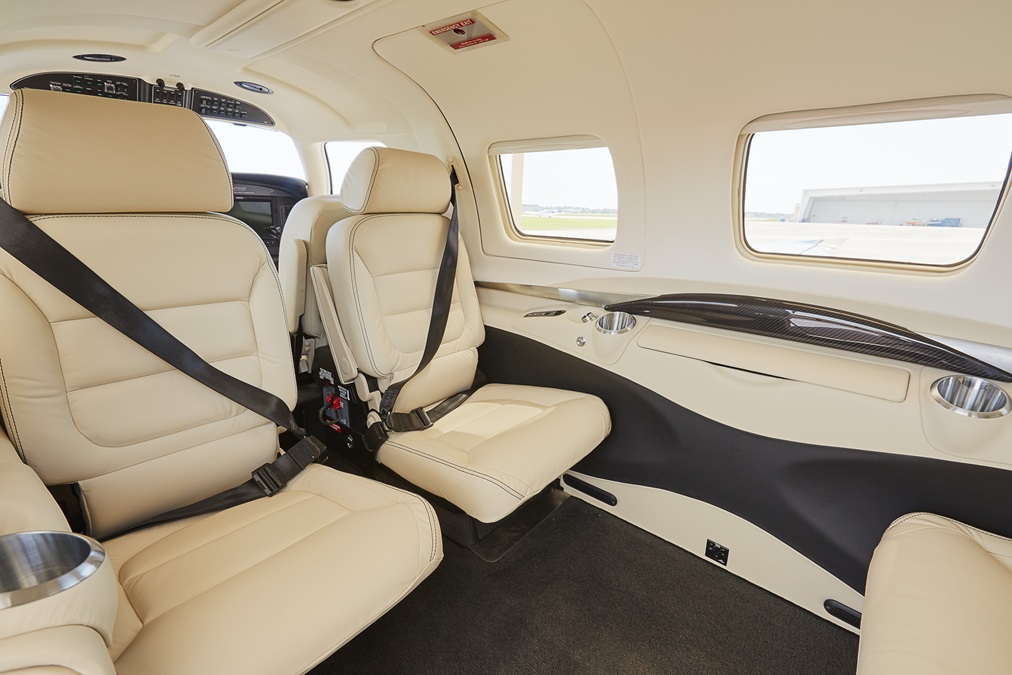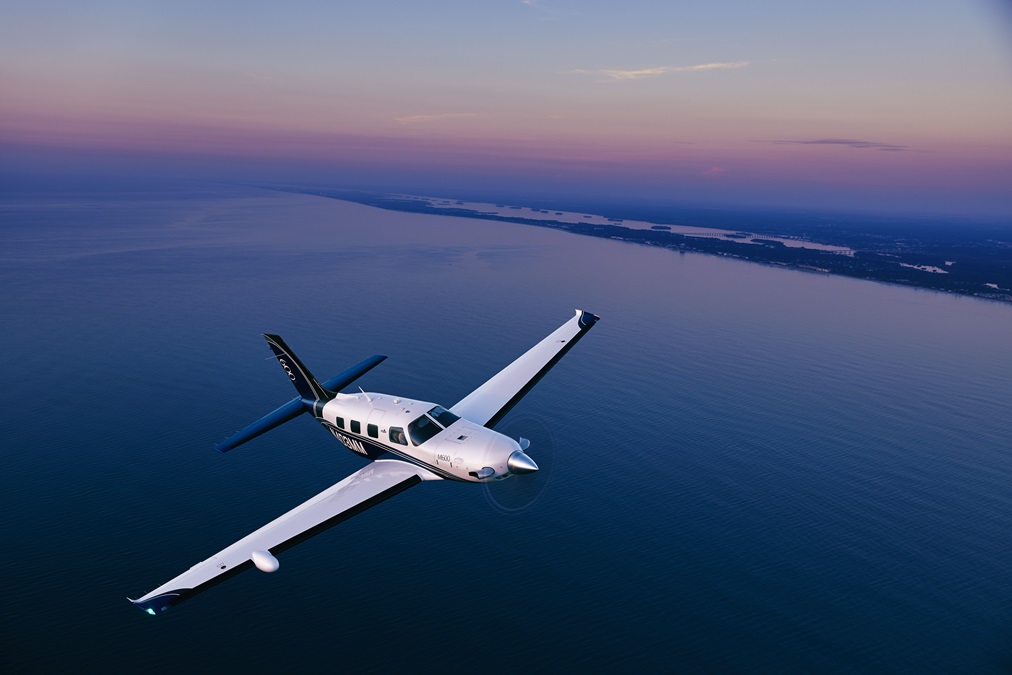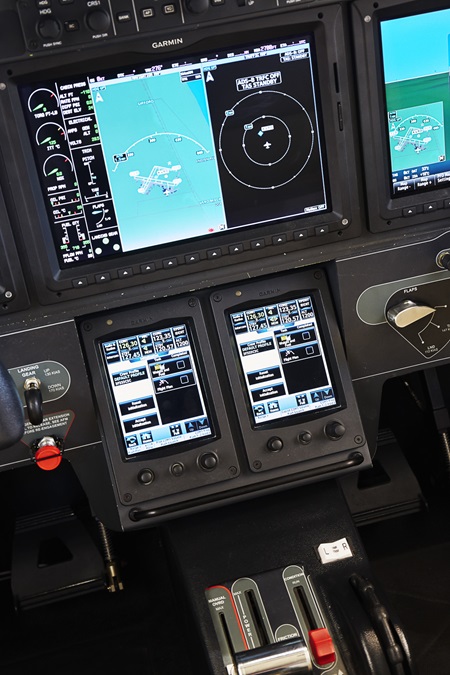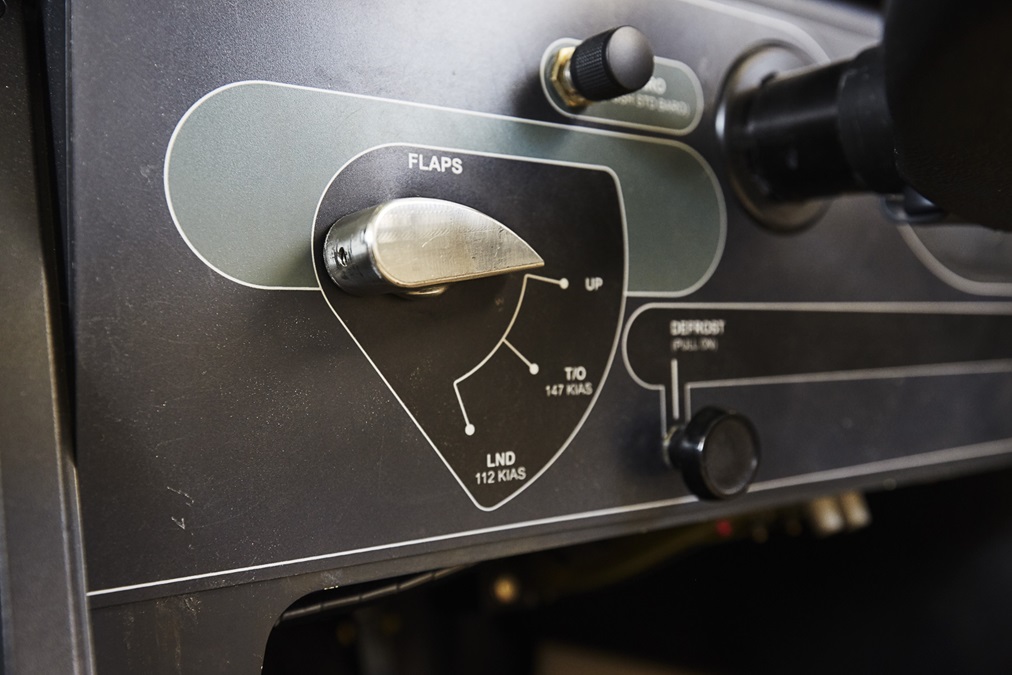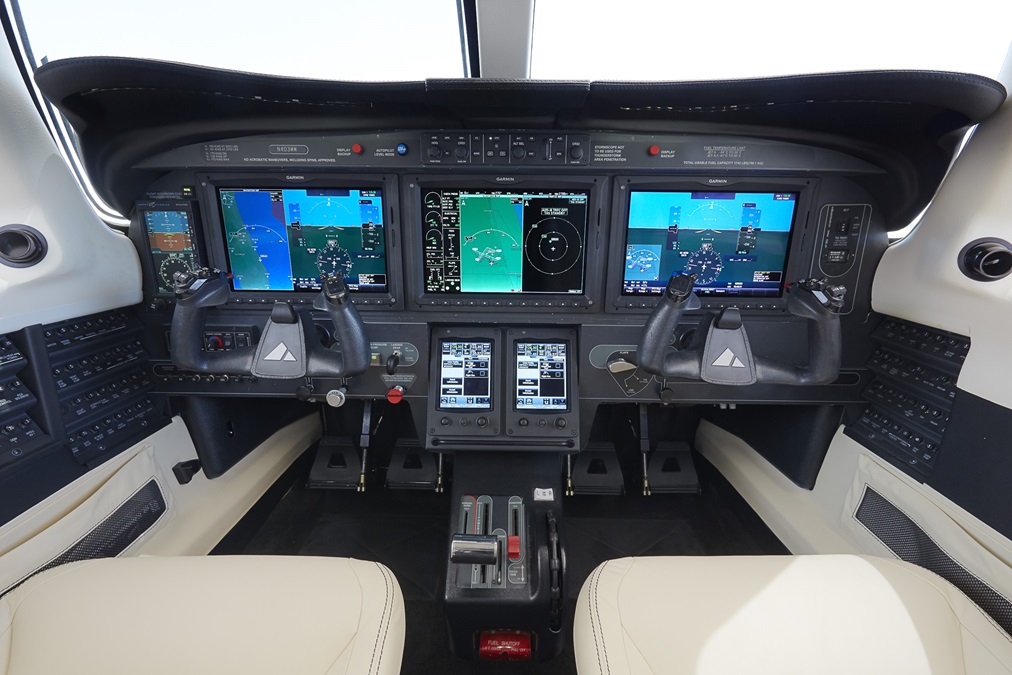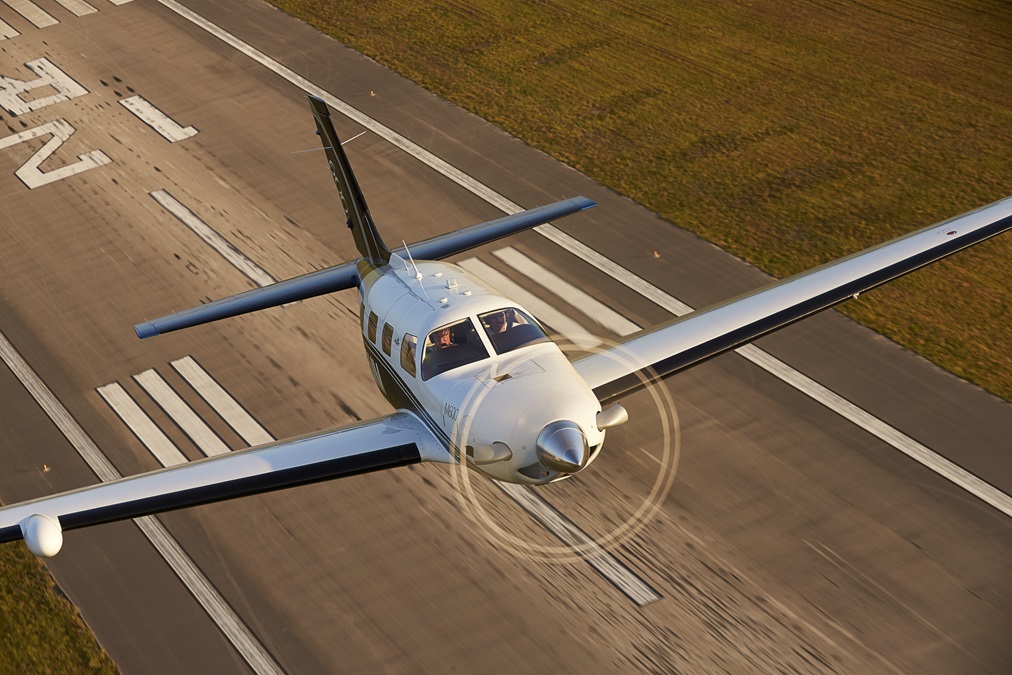The M-series steps it up
More features for a revamped design
Like all the other Piper “M-Class” airplanes—including the M350 (formerly the Mirage)—the M600 shares the same fuselage barrel and internal dimensions. But that’s where the similarity ends. The M600’s Pratt & Whitney PT6A-42A engine is rated at 600 shaft horsepower—100 more than the M500’s powerplant. It has a 1,000-pound greater maximum takeoff weight, and advertises a maximum range of 1,484 nautical miles (at maximum endurance power settings), and a maximum full-fuel payload of up to 700 pounds. Maximum cruise speed is up, too. The M600 can top out at 274 KTAS; the M500 comes in at 260 KTAS.
The first thing you notice when approaching the M600 is its new wing. Although its wingspan is a tad wider than the M500’s, it’s the smooth, tapered, and bonded construction; longer and larger flap area; and heavy-duty landing gear that catch the eye. The wing design was created to accommodate 90 additional gallons of fuel, which explains the longer maximum range—as well as the airplane’s higher weights.
With its longer legs, higher full-fuel payload, and advanced cockpit, the M600 seems to be an optimization of the basic M-series design concept.There’s even bigger news in the cockpit. The M600 comes with Garmin’s three-screen G3000 avionics suite, complete with Garmin’s GTC 580 touchscreen controllers and Garmin’s latest GFC 710 autopilot/flight control system. Besides their high resolution, the G3000’s displays have a split-screen capability. Also included is flight envelope protection via the airplane’s GFC 710 autopilot. This includes underspeed and overbank alerts, plus other safety enhancements such as a hypoxia alert annunciator and chimes, and an emergency descent mode (EDM) that automatically turns and descends the airplane to 14,000 feet. And up on the glareshield is a blue LVL button. Should the pilot find himself in an unusual attitude, press LVL and the airplane’s GFC 710 will roll it wings-level and return it to a level pitch attitude.
Here’s a quick rundown of how the hypoxia alert system works. First, a single chime sounds, and an annunciator asks “Are you alert?” If you don’t press any button on the primary flight displays, multifunction display, or autopilot controller within 60 seconds, a double chime sounds, and you get a Hypoxia Alert master caution annunciation. If you’re still unresponsive, a repeating triple chime goes off, a red Auto Descent master warning appears on the PFDs, and the airplane automatically descends to 14,000 feet. Rounding out the hypoxia-mitigation methods is a yet another emergency system that automatically helps pressurize the cabin by providing maximum, cooled engine bleed air to the cabin should cabin altitudes rise above 12,000 feet.
Production of the M600 was just beginning when we visited Piper’s Vero Beach, Florida, on a hot July day and flew serial number four, N403MM. The M600 is easy to operate, right down to a start sequence that automatically shuts off the starter at 50-percent NG (gas generator/compressor speed) and does away with high or low idle settings for the condition lever. The lever acts as a simple On/Off valve.
There’s a fair amount of residual thrust, so for taxiing it’s best to use the beta power lever range to keep taxi speeds down and spare the brakes. The power lever has gates for both the beta and reverse thrust positions.
Takeoffs are equally uncomplicated. Hold the brakes, power up to a value slightly below torque redline (torque will rise as you accelerate down the runway), release the brakes, and off you go. Rudder forces seem remarkably light, so it takes a little care to track the centerline. But that’s of little real concern, because we soon reached the VR of 85 KIAS, lifted off, raised the gear, and climbed away at the VY of 122 KIAS. With three aboard and full fuel, our initial rate of climb was 1,350 fpm. Not bad for 80 degrees Fahrenheit, which works out to ISA +21 degrees Celsius.
ATC gave us some altitude restrictions during the climb to FL280, but the pilot’s operating handbook (POH) says that we could have flown direct to that altitude in about 30 minutes while covering 85 nm and burning 170 pounds of fuel (about 25 gallons) in the process. That’s at our ISA +15 conditions; at ISA, the climb would have taken 26 minutes, 155 pounds (23 gallons) of fuel, and 69 nm.
The M600 POH publishes two high-speed cruise settings. One, for maximum cruise speed, is a Piper-supplied number, and up at FL280 and ISA +13 degrees (an OAT or static air temperature of minus 27 degrees Celsius) gave us a 274-KTAS cruise speed burning 280 pph (42 gph), with the interstage turbine temperature (ITT) parked just short of its 800-degree-Celsius redline. Yes, we were temperature-limited (and had been since climbing through FL230), which meant that we had to pull back the power lever to 1,310 foot-pounds in order to stay below the all-important ITT redline. Pratt & Whitney doesn’t recommend using this power setting, and it says so in the performance tables—probably because of the relatively high ITT values, which aren’t conducive to long engine life.
The other high-speed cruise setting is called “Normal” cruise power, and is recommended by Pratt & Whitney. This called for a torque setting of 1,150 foot-pounds, which produced a cooler, 745-degree ITT, a fuel burn of 245 pph (37 gph), and a 264-knot true airspeed. Dialing in the long-range view on the MFD’s moving map, I could see that our range—with 45-minute reserves—under our current conditions ran as far as the northern tip of Michigan. Not bad: Central Florida nearly to Ontario, nonstop, in three hours, 18 minutes. And this, with our current fuel load of 985 pounds (148 gallons).
Demonstration pilot Bart Jones boasted that he flew an M600 nonstop from Vero Beach to Groton, Connecticut; flew a missed approach; diverted to Providence, Rhode Island; and landed—with 600 pounds (about 90 gallons) of fuel reserves. “It’s a solid, five-hour, 45-minute airplane,” Jones said.
The M600 feels solid and stable, thanks to the new wing and extra weight. If the ailerons seem a little heavy, well, that comes with the territory. Besides, in IFR operations it’s always better to have an airplane that “stays put”—which the M600 definitely does. But if things do get out of hand, there’s always the envelope protection to help out. Any time the autopilot is off, a soft roll limit of 35 degrees is posted on the attitude indicator. Go past the roll markers and the GFC 710 fights back. Roll more, and it fights harder. Yes, you can go knife-edge, but you’ll be working pretty hard against the autopilot servos. Get too close to a stall, and the autopilot kicks on automatically and pitches the nose down. As for the EDM, the M600’s higher, 251-knot VMO means quicker descents. With the M500’s 188-knot VMO, the airspeed would come up against VMO during the EDM maneuver, which explains why the feature isn’t available in that airplane.
The M600’s higher VMO also lets pilots more easily comply with those slam-dunk descent clearances. The M5000’s 60-knot-slower VMO is an issue in these cases, especially given that the airplane has no speed brakes.
Like every other maneuver, landings in the M600 are straightforward. Use an initial airspeed of 100 to 120 knots, and then bleed off airspeed for a VREF on short final of 85 knots. The airplane doesn’t have trailing-link landing gear, so there’s an incentive to making a nice, smooth, slow, nose-high touchdown. I think the grade for my first landing was a C—well, maybe a C-minus. But the next was a B, I’m pretty sure. Hey, it was my first time in the airplane, and practice makes perfect. Anyway, look at the video and judge for yourself (www.aopa.org/pilot/M600).
The new warranties—five years on everything but the engine, with its seven-year/2,500-hour warranty—sweeten the deal. It would be nice, though, if some of the options were standard—fire detection, TAWS-B, XM WX Satellite Weather, L-3’s WX-500 Stormscope, and Jeppesen’s ChartView, for example. Right now, the M600 is Piper’s top-of-the-line offering. With its longer legs, higher full-fuel payload (N403MM’s was 658 pounds; the M500’s is listed as low as 340 pounds), and advanced cockpit it seems to be an optimization of the basic M-series design concept.
However, designs have their limits, and derivatives can lose ground in the marketplace. The next step up in capability will certainly require a massive redesign. Or a completely new airplane.
Piper hints strongly that future designs are on the drawing table. One official even went so far as to suggest a jet—but not a revival of the single-engine PiperJet/Altaire, which was put on hold five years ago. Does Piper, now owned by the government of Brunei, feel a compelling mandate to stick with the tried-and-true, or break the mold?
Email tom.horne@aopa.org

